Remote Towers Market Research, 2031
The global remote towers market size was valued at $318.7 million in 2021, and is projected to reach $1,033.3 million by 2031, growing at a CAGR of 11.7% from 2022 to 2031. Remote & virtual towers are used to regulate, assist, and maintain orderly air traffic operations remotely, unlike the local ground-based control tower. Remote towers are being adopted quickly by modern airports for faster & safe airport operation. For instance, in December 2018, Saarbrucken Airport (an airport in Saarland, Germany) deployed the Germany’s first remote tower to control air traffic from a city Leipzig (a city in Germany), 450 KM away from Saarbrucken. This remote tower is operated by Deutsche Flugsicherung (DFS), the company in-charge of air traffic control for Germany. Such investments in remote & virtual towers is expected to increase air traffic management efficiency. Owing to this the major international airports across the globe are implementing remote tower solutions.
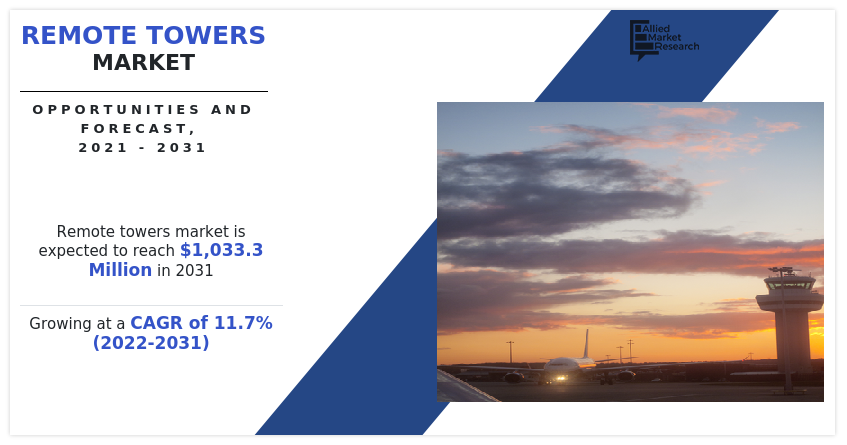
Factors such as need for better airspace management systems, increase in demand for cost effective air traffic control solution, and rise in the number of airports are anticipated to boost the growth of the global market during the forecast period. However, threat of cybersecurity and data breach and lack of standardization are expected to hinder the growth of the global market during the forecast period. Moreover, digitalization in air traffic management and rise in air-traffic are expected to create an opportunity for the market in near future.
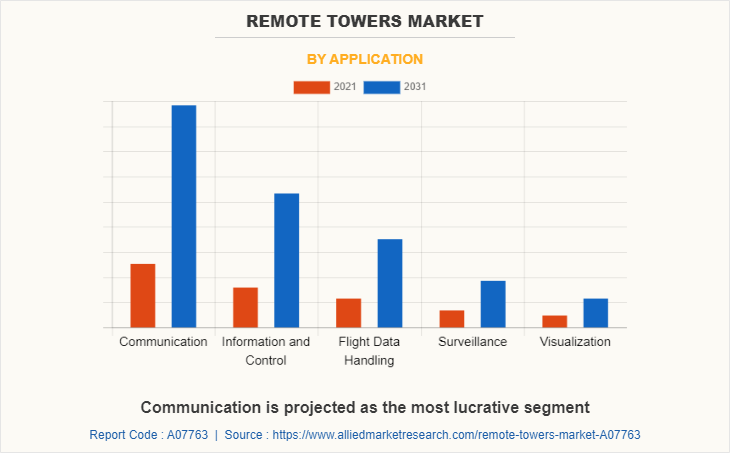
The remote towers market is segmented on basis of application, end user, operation type, offerings, and region. By application, it is divided into communication, information & control, flight data handling, surveillance, and visualization. By end user, it is divided into military airport and commercial airport. By operation type, it is divided into single, multiple and contingency. By offerings, it is segmented into hardware, software & solutions, and services. By region, the market is analyzed across North America, Europe, Asia-Pacific and LAMEA.
The key players that operate in this remote towers market are ADACEL, Becker Avionics GmbH, DFS Deutsche Flugsicherung GmbH, EIZO Corporation, Frequentis Group, Indra Sistemas, Kongsberg Gruppen, L3Harris Technologies, Leidos, Leonardo S.P.A, Northrop Grumman Corporation, Raytheon Technologies Corporation, RETIA AS, ROHDE & SCHWARZ, SAAB AB, Searidge Technologies, and Thales Group.
Need Of Better Airspace Management Systems
In accordance with the data releases by international civil aviation organization (ICAO), the number of departures reached about 37.8 million in 2018, which was a 3.5% increase over 2017. This data clearly indicates the increase in the global air traffic. This results in increased burden on the existing air space management solutions, which translates into high higher risk of the air fatalities. For instance, the global aviation accident rate increased to 2.6 accidents per million schedule departures for 2018, from 2.4 accidents per million scheduled departures in 2017.
Owing to this, there is a need for better airspace management solutions. A remote tower enables Air Traffic Control (ATC) services to be provided at an airport from a remote location, instead of from the conventional ATC tower situated at the airport. The remote tower services use high resolution cameras, microphones, sensors, and a local processing system, which enables the air traffic controller to provide the same ATC services from remote location. Owing to all these factors, the demand for better airspace management system is expected to fuel the remote towers market.
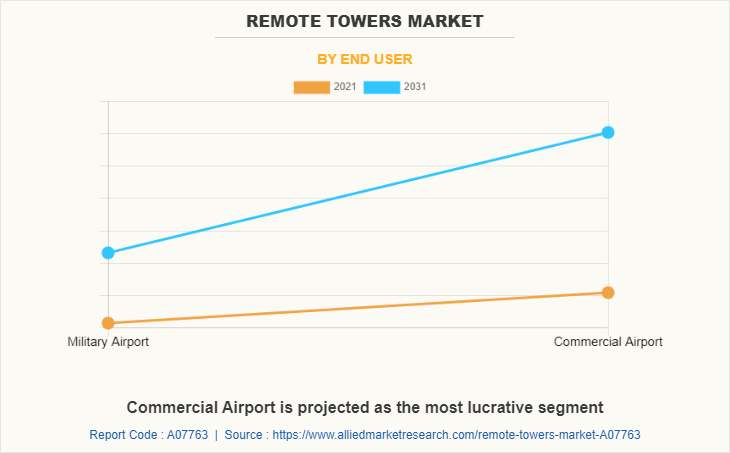
Increase In Demand For Cost Effective Air Traffic Control Solution
Remote towers can operate a single airport or multiple airports from a remote location. The use of remote towers saves money on civil infrastructure and air traffic control systems. Due to high air traffic control (ATC) tower costs, the operations of small- and medium-sized airports with low traffic is not cost effective.
The remote towers systems can operate and control such multiple airports from a single location simultaneously and sequentially, according to a schedule. The cost of having independent towers at such airports is prohibitively expensive when compared to installing a high-tech camera system that relays video footage to a remote tower for ATC operations. Owing to this, many countries are implementing remote tower services for their air traffic management operations.
For instance, in 2019, first remote tower technology was installed in Norway. Moreover, by end of 2022, 15 airports in Norway are expected to implement remote towers technology for their operations. This is expected to be significantly less expensive than building separate towers at each of these airports. The remote towers will handle the increased passenger traffic at a much lower cost than upgrading and developing traditional air traffic control towers. The need to reduce the costs of air traffic management is expected to drive the demand for remote tower.
Threat Of Cybersecurity And Data Breach
According to the International Air Transport Association (IATA), cyber-attacks on aviation industry costs the airline industry$460 billion annually. In the next three years, cyber security is anticipated to account for a sizable chunk of over $33 billion in IT spending for airlines and airports. Hackers/attackers can take advantage of the software vulnerabilities of advanced system used in remote towers so as to exploit air traffic control (ATC) systems, which in turn could result in air traffic fatalities.
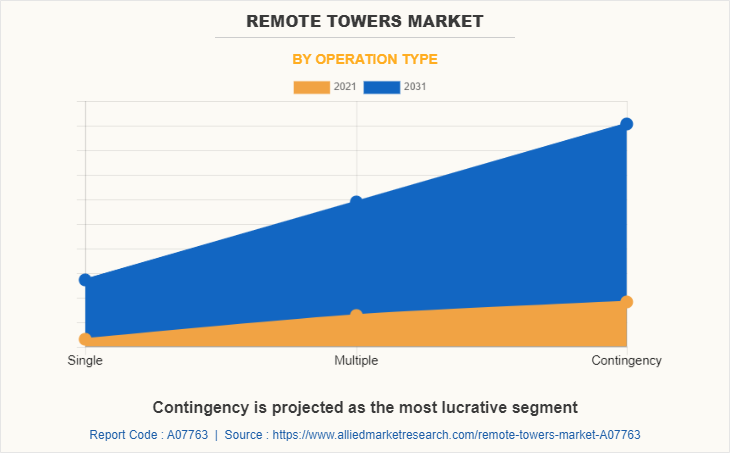
In addition, in line with the report released by the U.S. Government Accountability Office (GAO), the cybersecurity weaknesses could lead to extreme disruptions and undermine the safety of the country’s ATC system. Hence, to avoid such cyber-attacks, cybersecurity in air traffic management (ATM) becomes more of a priority. This requires companies and regulators to focus more on the technological solutions as well as potential applications of artificial intelligence (AI) and blockchain to avoid the potential risk of cyber threat. Such potential risk of cyber threat is expected to hamper the growth of the remote towers market.
Digitalization In Air Traffic Management
The aviation industry is undergoing a significant technological transformation. Advanced technologies, such as unmanned aircraft & drones, digital airport technologies, and digital MRO are shifting the industry toward digitalization. Remote towers system is one of the newest and technologically advanced system, which replaces human out-of-the-window view with highly automated digital equipment.
Moreover, the remote towers use aeronautical data and automated algorithms for digital anti-collision mapping and terrain mapping. For instance, ENAIRE and Indra Sistemas are working on digital control tower project through which they are developing remote provision for tower control traffic services.
This advanced solution is based on based on the application of augmented reality and artificial intelligence. This solution integrates the air traffic communications systems, air traffic control (ATC) and air traffic service (ATS) surveillance data with a panoramic visualization system and is equipped with innovative information and alert functionalities. Such developments are helping air traffic management system to shift from the visual operations to a new digitalized air traffic management system. Owing to all these factors, the digitization in air traffic management is expected to propel the remote towers market during the forecast period.
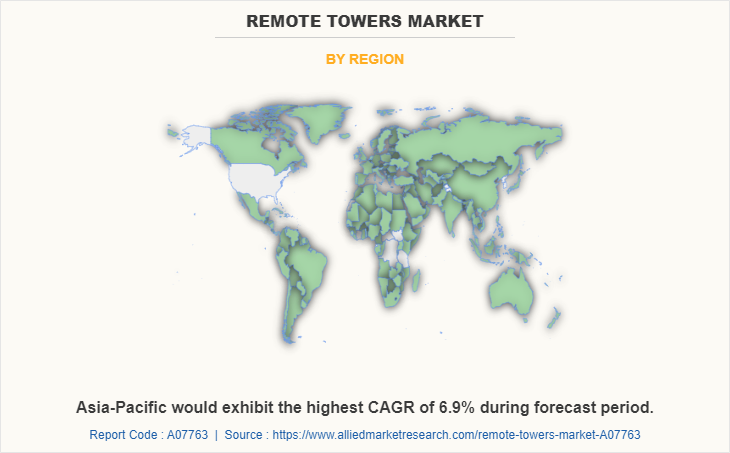
Key Benefits For Stakeholders
This report provides a quantitative analysis of the market segments, current trends, estimations, and dynamics of the remote towers market analysis from 2021 to 2031 to identify the prevailing remote towers market opportunities.
The market research is offered along with information related to key drivers, restraints, and opportunities.
Porter's five forces analysis highlights the potency of buyers and suppliers to enable stakeholders make profit-oriented business decisions and strengthen their supplier-buyer network.
In-depth analysis of the remote towers market segmentation assists to determine the prevailing market opportunities.
Major countries in each region are mapped according to their revenue contribution to the global market.
Market player positioning facilitates benchmarking and provides a clear understanding of the present position of the market players.
The report includes the analysis of the regional as well as global remote towers market trends, key players, market segments, application areas, and market growth strategies.
Remote Towers Market Report Highlights
| Aspects | Details |
| By Offerings |
|
| By Application |
|
| By End User |
|
| By Operation Type |
|
| By Region |
|
| Key Market Players | BLACK BOX, LEIDOS, L3HARRIS TECHNOLOGIES, FREQUENTIS GROUP, RETIA A.S, LEONARDO S.P.A, BECKER AVIONICS GMBH, KONGSBERG GRUPPEN, DFS DEUTSCHE FLUGSICHERUNG GMBH, ROHDE & SCHWARZ GMBH & CO., SAAB AB, SEARIDGE TECHNOLOGIES, INDRA SISTEMAS, ADACEL, RAYTHEON TECHNOLOGIES CORPORATION, THALES GROUP, NORTHROP GRUMMAN CORPORATION |
Analyst Review
The remote tower market is expected to witness significant growth, due to growth in population along with increase in disposable income, which will result into increase in the domestic as well as international flights. Companies in this industry are adopting various innovative techniques to provide customers with advanced and innovative feature offerings. Experts also predict that the aviation industry is facing extreme high growth in air traffic, commercial flights as well as the military and defense flights. For example, European airspace records more than 33,000 flights per day. These figures will be doubled by the end of 2030 as per EUROCONTROL, European Organization for the Safety of Air Navigation.
Factors such as need for better airspace management systems, increase in demand for cost effective air traffic control solution, and rise in the number of airports are anticipated to boost the growth of the global remote tower market during the forecast period. However, threat of cybersecurity and data breach and lack of standardization are expected to hinder the growth of the global remote tower market during the forecast time period. Moreover, digitalization in air traffic management, and rise in air-traffic is expected to create an opportunity for the remote tower market in near future.
To fulfil the changing demand scenarios, market participants are involving in contracts to meet new business opportunities. For instance, in February 2022, Saab Digital Air Traffic Solutions (SDATS) signed a contract to deliver a digital tower to providing air navigation services at the newly built Brasov-Ghimbav International Airport in Romania. The services will be operated by ROMATSA, the air navigation service provider of Romania. Moreover, in December 2019, Saab Digital Air Traffic Solutions (SDATS) signed a 20-year framework agreement with the Dutch Air Traffic Control (LVNL) for remote tower systems. SDATS received its first order under a framework contract to build remote towers at Groningen and Maastricht airports and a remote tower center at Schiphol airport. The basic contract includes additional airport and feature options. In addition, market participants are continuously focusing on product launch to expand their product portfolio. For instance, in June 2022, Kongsberg Gruppen announced the launch of the world’s biggest remote tower in Bodo. The new center is expected to be in a new building, from which 15 towers at the same number of airports will be remotely controlled. Currently, about four airports are already remotely controlled from Bodo's remote tower center. These are Røst, Vardø, Hasvik and Berlevåg.
The key players that operate in this market are ADACEL, Becker Avionics GmbH, DFS Deutsche Flugsicherung GmbH, EIZO Corporation, Frequentis Group, Indra Sistemas, Kongsberg Gruppen, L3Harris Technologies, Leidos, Leonardo S.P.A, Northrop Grumman Corporation, Raytheon Technologies Corporation, RETIA AS, ROHDE & SCHWARZ, SAAB AB, Searidge Technologies, and Thales Group
Global increase in population is anticipated to create demand for the additional airports to facilitate the growing demand for air transportation, which is driving the market growth.
Asia-Pacific region accounted for the largest remote towers market share.
The key players that operate in this market are ADACEL, Becker Avionics GmbH, DFS Deutsche Flugsicherung GmbH, EIZO Corporation, Frequentis Group, Indra Sistemas, Kongsberg Gruppen, L3Harris Technologies, Leidos, Leonardo S.P.A, Northrop Grumman Corporation, Raytheon Technologies Corporation, RETIA AS, ROHDE & SCHWARZ, SAAB AB, Searidge Technologies, and Thales Group.
The global remote towers market to grow at a CAGR of 11.7% from 2022 to 2031
The global remote towers market was valued at $318.7 million in 2021, and is projected to reach $1,033.3 million by 2031, growing at a CAGR of 11.7% from 2022 to 2031
Loading Table Of Content...


